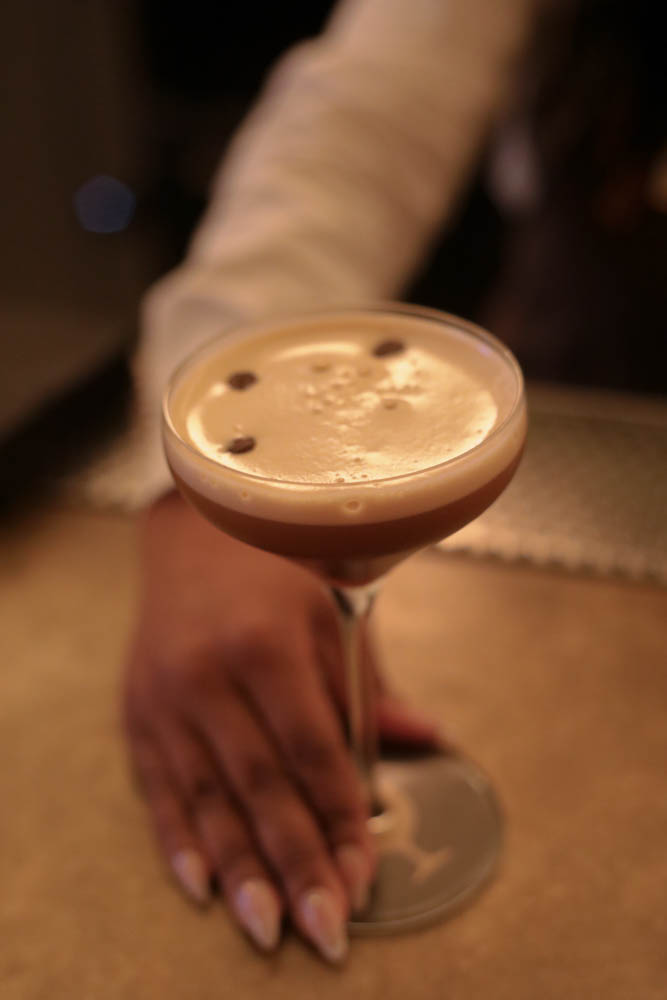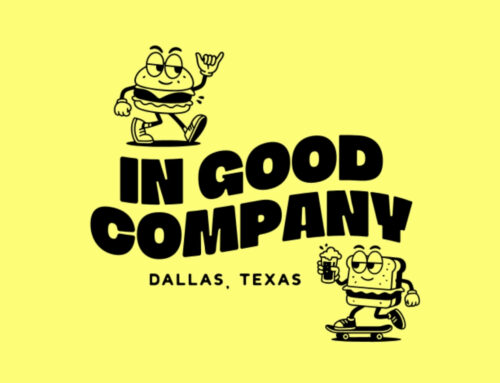
Photography by Cat Iler.
It’s 4:15 p.m. at Goodwins on Greenville. A cluster of bartenders huddle next to the bar. It’s pre-shift. They all wear white collared button down shirts with black ties, black pants and brown aprons. In the cluster is a woman sporting glasses and a content smile. Twenty-six-year-old Micah Bernard. She is one of two women staffed at the front bar for tonight. In total, there’s three.
Bernard tucks a green reusable water bottle and a small brown box filled with “snackies” that will serve as dinner for the shift in a small nook. Bernard takes her place at the corner of the bar, closest to the entrance – it’s called the “personality.” The first face you see when you come in.
This kind of Wednesday night wasn’t always part of her plan. She went to Southern Methodist University, majoring in English and, after graduating, she felt herself begin to pivot.
“Genuinely, I was just lost,” she says. “I had no idea what I was doing with my life, and that was totally unlike me.”
Bernard needed some time to figure out the next step, something that felt natural.
She always had a palette for alcohol and even before she could drink it, she was known for working up some sort of juice concoction for family members during gatherings at home. In hindsight, becoming a bartender made sense. Although she never anticipated it.
“In my mind, I was doing it for fun, to basically give me a year of time,” she says.
Bernard cracks a smile as a regular makes his way in. He calls her by name. They laugh and joke as she thumbs through garnishes. The year of time she needed has now turned into two.
“I had only planned on bartending or being in the industry for about a year, and I was like ‘I’m just gonna take a gap year, go back to school, figure out what I want to do,’” Bernard says. “And I was like, ‘Oh my gosh, I actually love this.’ I am still going back to school, but I realized that there was no rush to leave the industry when I had so much support to stay.”
She’s relaxed as she pours, stirs and slides drinks across the bar, smiling at patrons. When she first started – as a barback – this interaction wouldn’t have been possible.
“When you’re a barback, you just keep your head down and you do your job,” she says.
As a barback, you prep the space, handle kegs and do the groundwork for the bartender but you never interact with guests. That’s a no-no. Barbacks are common. But a woman being a barback? Not so much. Let alone, one that is 5-feet even.
“I definitely had to work out to get up my strength to be able to do the job,” Bernard says.
The world of bartending
Bernard is originally from Arkansas, so making herself at home in Dallas was top of mind. She knew the city was where she was “meant to be.” After making the jump from barbacking to bartending, she began to create a community among her peers.
Drinks after a shift was their form of team building. She began rubbing elbows with people who had been in the industry for years. She was learning and bonding and eventually, she was fully in the mix.
She has now served as a bar lead, a restaurant supervisor and has also taken on private events like happy hours and weddings.
Bernard is considered a craft bartender, focusing on the presentation, quality and flavor profiles a drink can offer.
“The first way that you taste a cocktail is with your eyes,” Bernard says.
This way of thinking isn’t necessarily prioritized in a club or dive bar environment, known for being more casual. Bernard clarifies that speed is a component in almost all forms of bartending and that different types of bars lend themselves to different styles of bartending.
Alongside learning from her peers, Bernard attributes her growth to simply doing the job.
“You can go to bartending school, or you can serve tables, you can be in the industry, but there’s nothing like the tangible work and actually experiencing and getting the reps in,” she says. “And that’s really important for me, because I had never been beyond just ordering a drink that I knew.”
Bartenders can also further their education within the craft through educational drink making classes. Usually put on by spirit ambassadors whose goal is to have their brand used in a bar’s drinks, the classes have become a way for bartenders to meet one another.
“It can definitely take over your life if you let it. That’s why some people do this their entire life. It’s genuinely a full career,” she says.
With so many options for development, there’s even niche groups within the bartending community. Being only one of three women in her bar, Bernard has looked for other women in the space. This pursuit led her to finding The Shake Up, a local cocktail competition started by Rosie Sullivan for women bartenders in the area.
Bernard shares that she usually runs into the expectation that women are only servers or cocktail workers in the industry.
But the ratio at Goodwins beats her last job, where the grand total number of women working the bar was one: Bernard.
“Unfortunately, women are not as prevalent,” Bernard says.
The Dallas scene
As the city of Dallas expands, so does the bar culture. The city’s nightlife has grown and evolved with social media. People are eager to show their nights out with friends or share a day in their life – putting craft cocktails directly in front of the camera.
“My experience of making a cocktail is immediately having placed a cocktail in front of a guest, knowing that they’re possibly going to take a picture is something that we all have to think about,” she says.
Bernard has seen it plenty of times: a group making their way into the bar, pulling out their phones and recording Tik Toks and snapping photos of their food, drinks and peers.
It has an air of show business to it. Lights, cameras and certainly lots of action. Bernard notes that since starting in 2022, the pace of bartending has changed.
“It’s definitely more intense. Just more people are out. More people are wanting to explore and experience new places,” she says. “The social scene of Dallas is definitely going to eat and going to bars, just wanting to hang out, go to the hottest new places.”
Bernard’s fear is that the intensity will push Dallas bars toward prioritizing speed bar environments, rather than championing casual neighborhood spots.
Although the fear of a more commercialized version of bar culture looms over the future as a possibility, tonight feels familiar and warm. A football game flashes across the televisions as soft rock music echoes throughout the chatter-filled space.
It’s now 5:45 p.m. at Goodwins’ front bar. Bernard is still floating around the personality portion of the bar, as it becomes cluttered with after work conversations and solo visitors, all washing down the day with their drinks of choice.
Bernard braces herself, as this is the last part of the shift that can be considered slow before it ends at 11 p.m.







